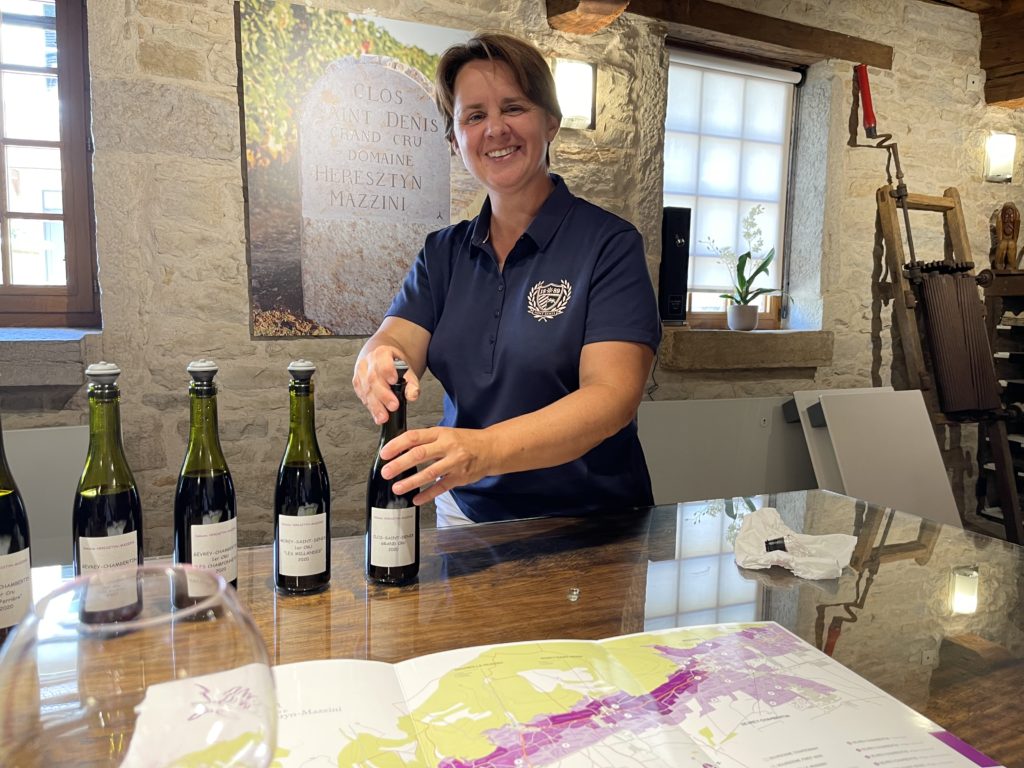Domaine Heresztyn-Mazzini. Yes, Domaine Heresztyn-Mazzini. It is a long and difficult name, and probably not the greatest marketing asset given to Florence and Simon Mazzini.
But names tell a story, give some history, and are therefore important in how we present ourselves to the world. Sometimes the names are unpronounceable and even unspellable, but in the end, one learns to work with it.

I have myself a difficult name: “Øhman,” with the “Ø” being very difficult. Even the Swedish alternative Öhman is somewhat challenging to many. But this name carries a link to my family in Finland and my father’s history – very important to me, as it turns out. So I understand Heresztyn-Mazzini, and why it is worth the marketing struggle.
Heresztyn-Mazzini carries Polish heritage going back to the grandfather of Florence (Heresztyn) Mazzini, whose husband Simon comes from a Champagne background.
With names like theirs, I always use copy-paste when writing articles to ensure I get it right. And while names and marketing are certainly a big thing these days, as always, the truth is in the bottle and in the glass.
Bio, with a dynamic twist
Domaine Heresztyn-Mazzini works organically, meaning they are certified organic with the trusted AB certificate, a certification that ensures a level of trust – although not necessarily clarity.
In France, organic certification was introduced in 1985. It has established a green-white logo of “AB – agriculture biologique.” The certification for the AB label fulfills the EU regulations for organic food. French buyers and retailers often ask operators to label their products with AB trademark which refers to French organic products and is well known to French consumers.
This is France’s organic certification. It is sort of clear, although most don’t feel the need to dig into it, much less into the minutiae of the rules for organically certified growers.
In addition, Domaine Heresztyn-Mazzini uses biodynamic preparations (amongst others the 500 and the 502 mixtures), indicating another level of commitment and a wish to move further down the biodynamic road.
For information, the biodynamic preparations are:
- Horn manure preparation (P 500)
- Horn Silica preparation (P 501)
- Yarrow preparation (P 502)
- Camomile preparation (P 503)
- Nettle preparation (P 504)
- Oak bark preparation (P 505)
- Dandelion preparation (P 506)
- Valerian preparation (P 507)
I am not an expert here, but the wines from – copy/paste (hehe) – have a truly organic feel, meaning a liveliness to the acidity and the fruit mainly found in wines that are exploring the biodynamic way. So this estate is definitely worth looking at and following, in my opinion.
The wines tasted
Due to the pandemic and illness, I have not been able to follow Domaine Herensztyn-Mazzini over the past few years. But already in the 2015 and 2016 vintages, there was a stylistic “battle” going on between whole clusters and destemmed grapes. A battle in the sense that Florence and Simon were trying to determine how much – or whether -they wanted to increase the whole-cluster part.
In my opinion, there’s no doubt: Especially in a rich year like 2020, whole clusters work very well, as was also the case in the 2015 vintage.
To the notes!
Domaine Heresztyn-Mazzini Gevrey-Chambertin Clos Village 2020
Rich, slightly reduced, and with very good acidity, on the energy side it lacks some tension in the slightly darker fruit. It’s 50% destemmed, with 25% new oak from Chassin. This has an old-vine feeling, but the concentration prevents it being a vin de soif – it’s almost too generous for its own good. Perhaps a higher percentage of whole clusters would have lightened it a bit?
(Drink from 2029) – Very Good (88p) – Tasted 17/06/2022 – ![]()
Domaine Heresztyn-Mazzini Gevrey-Chambertin Les Jouises 2020
This has the goods: 90% whole-cluster vinification, and bottled in February. It’s vivid and lively; the whole clusters do give the wine more zap and vivacity. Lovely, silky, and velvety, this has a decadent note. It’s from the vineyards Les Jouises and Fournaux, just above and below the main road – a lovely mixture. Still quite intense, but with the energy to match.
(Drink from 2029) – Very Good (90p) – Tasted 17/06/2022 – ![]()
Domaine Heresztyn-Mazzini Gevrey-Chambertin Les Songes 2020
This is a Tres Vieilles Vignes cuvee, with the oldest vines in Songes having seen more than a century. It has the depth and intensity brought by these truly ancient vines. It’s effortless, juicy, and sensual; lively, with a deep inner tension. Magnificent juice.
(Drink from 2033) – Very Good (91p) – Tasted 17/06/2022 – ![]()
You need to login as a Premium subscriber to read the rest of this article. If you are not a Premium Subscriber, use the subscribe function and sign-up.


 - A true vin d’émotion – a Burgundy of passion
- A true vin d’émotion – a Burgundy of passion - A truly hedonistic wine – lively and enjoyable
- A truly hedonistic wine – lively and enjoyable - A vivacious wine for pure indulgance
- A vivacious wine for pure indulgance - A potential vin d´émotion - frais et léger
- A potential vin d´émotion - frais et léger
Leave a Reply
You must be logged in to post a comment.